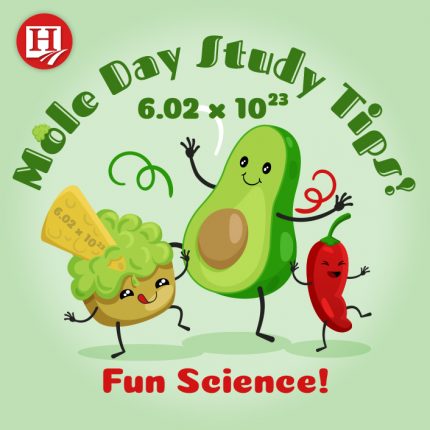
Mole Day Study Tips
October 16, 2018Mole Day? Nope, not a furry mammal… No, not a sauce from Mexican cuisine… and, nope not even Guacamole (which is amazing by the way!) I’m sure all of our chemistry and math nerds know exactly what it means! (Yes, I’m including myself!) Mole Day is an amazing opportunity to have a little educational fun! Over the last 20 years, I’ve forgotten a lot of what was studied in high school, but one thing I’ll never forget is the Mole unit of measurement and the fun stuff we did to remember it! Let’s start our own Mole Day festivities and stay tuned to the end – we saved the best for last!!
What is a Mole?
The Mole is the unit of measurement for the amount of substance in the International System of Units. It is used extensively in the study of Chemistry as a way to express amounts of reactants and products of chemical reactions. Previously, the term gram-molecule was used to refer to essentially the same meaning, but can you imagine saying that really fast several times?
Ultimately, it was more convenient to call it a Mole! This number is expressed by that which is referred to as Avogadro’s constant, which has a value of approximately 6.02214076×10^23 mol−1. The termed was coined by a German chemist, Wilhelm Ostwald around the year 1900. It was translated from the German word for molecule “molekul.” And a quote from Mr. Ostwald, “the molecular weight of a substance, expressed in grams, shall henceforth be called mole.”
Why Celebrate Mole Day on October 23rd?
In the United States, Mole Day is recognized as October 23rd in honor of Avogadro’s number, which is approximately 6.022×10^23. Though this number has been accepted for general use since 1971, the General Conference on Weights and Measures agreed in 2011 to vote on a proposed redefinition of the Mol. In the proposed definition, the mole will have exactly 6.02214076 x10^23 specified “elementary entities”. The vote is to take place in November 2018 and the changes will go into effect by May 20, 2019.
Who was Amedeo Avogadro?
Amedeo Carlo Avogadro, according to Wikipedia was also known as Count of Quaregna and Cerreto (9 August 1776 – 9 July 1856), was an Italian scientist, most noted for his contribution to molecular theory now known as Avogadro’s law, which states that equal volumes of gases under the same conditions of temperature and pressure will contain equal numbers of molecules.
In tribute to him, the number of elementary entities (atoms, molecules, ions or other particles) in 1 mole of a substance, 6.022140857(74)×10^23, is known as the Avogadro constant, one of the seven SI base units and represented by NA.particles) in 1 mole of a substance, 6.022140857(74)×10^23, is known as the Avogadro constant, one of the seven SI base units and represented by NA.
Mole Day Free Chemistry Projects
- Mole Day Lesson for Middle School
- Mole Day Chemistry Project for High School
- Mole Lab Experiment
- Mole Day Practice Worksheet
Visit the Official Mole Day Site for lessons and activities to fill your day with learning and fun!
Mole Day Jokes (Get Your Fill of Corny)!
Q: What did Avogadro invent for his wife to use as a night cream?
A: Oil of Molay
Q: How much does Avogadro exaggerate?
A: He makes mountains out of molehills
Q: What element do moles love to study in chemistry?
A: Molybdenum
Q: What kind of fruit did Avogadro eat in the summer?
A: Watermolens
Q: Why was there only one Avogadro?
A: When they made him, they broke the Moled
Q: What kept Avogadro in bed for two months?
A: Moleonucleosis
Just for fun “Guaca MOLE” Recipe!
What would Mole Day be like without some fun food? Sure! Let’s head over to the kitchen and do a little chemistry experiment that we can actually eat! Here’s to Mole Day!
Great Guacamole Recipe
3 ripe Avocados
1 1/2 T Fresh lime juice
1/4 c Fresh tender Cilantro
1/4 cup of diced onions (soak in warm water for 10 minutes)
1/2 tsp Cumin
2 tsp minced Jalapeno pepper
1 large Fresh Romano tomato that has been de-seeded
1/2 tsp salt
Directions: Scoop the avocados and add lime juice and fork to separate. Stir in the cilantro, onions, cumin, Jalapeno, tomato, and salt. Taste and add additional if desired. Cover and refrigerate.
Jamie Gaddy
Jamie Gaddy, B.S., M.Ed., Ed.D. has been a college education professor for over 17 years. Education has been a part of her life in both the classroom and as a principal. Six children later found her dissatisfied with traditional school and homeschool became the better fit. She is also a pastor’s wife, editor, and entrepreneur who now homeschools four of her six children in Georgia. Jamie loves to share about her homeschool experience to help other homeschoolers find success. Connect with her at [email protected].
Latest Posts

This post is sponsored by Little Monsters Universe. I'm Tina Salmanowitz, an advocate for homeschooling and science education. With over a decade of experience as a science educator (in class…
Read more >
This post is sponsored by Time4Learning. Before the pandemic, it was business as usual for Boca Raton resident Nikki Warris. Her two daughters, 5-year-old Natalie and 8-year-old Lexi were…
Read more >
Are you a "Green Goddess" or a "Trash it Tom"? Recycling is an important thing we can all do to help preserve our environment. No doubt, you’ve heard the phrase “Reduce, Reuse, Recycle,”…
Read more >

